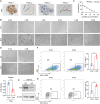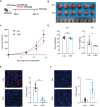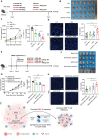Inhibition of FAK promotes pancreatic cancer immunotherapy by mediating CXCL10 secretion to enhance CD8+ T cell infiltration
- PMID: 40726089
- PMCID: PMC12309540
- DOI: 10.1080/2162402X.2025.2539442
Inhibition of FAK promotes pancreatic cancer immunotherapy by mediating CXCL10 secretion to enhance CD8+ T cell infiltration
Abstract
Immunotherapy has demonstrated potential in treating various malignant tumors, but its efficacy in pancreatic cancer (PC) remains limited, possibly due to the dense stromal components and immunosuppressive microenvironment of PC. Focal adhesion kinase (FAK), a non-receptor tyrosine kinase, plays a crucial role in the tumor microenvironment and intracellular signaling pathways. However, the specific role of FAK in the development and progression of PC, as well as its regulatory mechanisms on the tumor immune microenvironment (TIM), are still not fully understood. In this study, we analyzed single-cell sequencing datasets and clinical specimens to evaluate the role of FAK in the immune response of PC. We verified the impact of FAK alterations on CD8+ T cell infiltration using a co-culture system of patient-derived organoids (PDO) and immune cells. Additionally, mouse PC models and dual humanized models are established to investigate the in vivo function of FAK and the potential of its inhibitors for immunotherapy. Our results demonstrate that FAK is associated with the immunosuppressive microenvironment in PC. Inhibiting FAK enhances CD8+ T cell infiltration by promoting CXCL10 secretion in PC. Moreover, FAK inhibitors exhibit a synergistic anti-tumor effect when combined with immune checkpoint inhibitors. This study explores the potential of FAK as a therapeutic target, particularly its role in modulating TIM, thereby providing new research directions for the treatment of PC.
Keywords: CXCL10; Focal Adhesion Kinase (FAK); Pancreatic Cancer (PC); Tumor Immune Microenvironment (TIM); immunotherapy.
Conflict of interest statement
No potential conflict of interest was reported by the author(s).
Figures






Similar articles
-
Salvianic acid A enhances anti-PD-1 therapy by promoting HEV-mediated stem-like CD8 T cells infiltration in TNBC.Cancer Immunol Immunother. 2025 Jun 30;74(8):256. doi: 10.1007/s00262-025-04116-x. Cancer Immunol Immunother. 2025. PMID: 40586931 Free PMC article.
-
Oncolytic reovirus enhances the effect of CEA immunotherapy when combined with PD1-PDL1 inhibitor in a colorectal cancer model.Immunotherapy. 2025 Apr;17(6):425-435. doi: 10.1080/1750743X.2025.2501926. Epub 2025 May 12. Immunotherapy. 2025. PMID: 40353308
-
Sensitivity of Pancreatic Cancer Cell Lines to Clinically Approved FAK Inhibitors: Enhanced Cytotoxicity Through Combination with Oncolytic Coxsackievirus B3.Int J Mol Sci. 2025 Jul 17;26(14):6877. doi: 10.3390/ijms26146877. Int J Mol Sci. 2025. PMID: 40725124 Free PMC article.
-
Breaking the immune desert: Strategies for overcoming the immunological challenges of pancreatic cancer.Biochim Biophys Acta Rev Cancer. 2025 Sep;1880(4):189353. doi: 10.1016/j.bbcan.2025.189353. Epub 2025 May 22. Biochim Biophys Acta Rev Cancer. 2025. PMID: 40412630 Review.
-
Crosstalk between the tumor immune microenvironment and metabolic reprogramming in pancreatic cancer: new frontiers in immunotherapy.Front Immunol. 2025 Apr 28;16:1564603. doi: 10.3389/fimmu.2025.1564603. eCollection 2025. Front Immunol. 2025. PMID: 40356913 Free PMC article. Review.
References
-
- Patel JM, Cui Z, Wen ZF, Dinh CT, Hu H-M. Hu HM.Peritumoral administration of DRibbles-pulsed antigen-presenting cells enhances the antitumor efficacy of anti-GITR and anti-PD-1 antibodies via an antigen presenting independent mechanism. J For Immunother Of Cancer. 2019;7(1):311. doi: 10.1186/s40425-019-0786-7. - DOI - PMC - PubMed
MeSH terms
Substances
LinkOut - more resources
Full Text Sources
Medical
Research Materials
Miscellaneous
